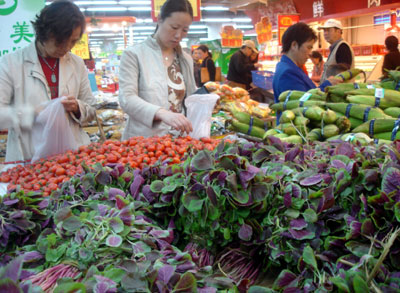CPI eases, rates hike pressure remains
By Dong Zhixin (chinadaily.com.cn)Updated: 2007-05-14 11:00
 Consumers shop at a supermarket in Suzhou, East China's Jiangsu Province April 27, 2007. China's Consumer Price Index, a barometer of inflation, rose three percent year-on-year, down from 3.3 percent in March, the National Bureau of Statistics said on Monday. [newsphoto] |
China's inflation eased in April, but barely meeting the government's target of three percent, increasing the pressure on the central bank to raise interest rates.
The Consumer Price Index, a barometer of inflation, rose three percent year-on-year, down from 3.3 percent in March, the National Bureau of Statistics said on Monday.
The increase was mainly driven by food prices which grew 7.1 percent while non-food items rose a mere 1.0 percent.
| ||||||
Among food items, egg prices jumped the most, by 30.4 percent, followed by edible oil and meat. Grain prices went up 6.1 percent.
The rural areas witness a price jump of 3.4 percent, bigger than 2.9 percent for the cities.
The figures upped the pressure on the People's Bank of China to hike interest rates as the country's real interest rate has been kept in negative territory. China's benchmark one-year deposit rate stands at 2.79 percent and interest income is subject to a 20 percent tax.
Another indicator of inflation, producer price index rose 2.9 percent in April from 2.7 percent in March, the bureau said on Friday.
What adds to the pressure for an interest rate increase is a drop in household deposits and higher lending activities.
Household deposits decreased by 167.4 billion yuan (US$21.7 billion) in April, compared with an increase of 60.6 billion yuan (US$7.9 billion) at the same time last year, the central bank said in a statement on its website on Sunday.
Meanwhile, household loans went up 123.6 billion yuan, a year-on-year increase of 63 billion yuan, according to the bank.
Given the lack of a substantial jump in consumption, analysts said, a major part of deposits and loans may have flowed into the stock market which has surged more than 50 percent so far this year on top of a 130 rally in 2006.
A total of 4.79 million new A-share trading accounts were opened in April, 853,500 more than the combined total for the previous two years, according to statistics from the China Securities Depository and Clearing Corporation.
From May 8 to 10, 1.03 million new accounts were added, more than the total number in 2005.
The wave of new money has consistently pushed the Shanghai and Shenzhen markets to new highs.
The benchmark Shanghai Composite Index broke the psychologically important barrier of 4,000 points on Wednesday, less than two months after surpassing the 3,000-point mark.
The sharp gains are once again raising worries about bubbles developing in the equity market.
If negative real interest rates are left un-checked, the sustainable development of the market will be in jeopardy, Goldman Sachs warned last week.
"To ensure the sustainability of the market over the medium term, we believe policy makers need to act quickly," economist Hong Liang of the investment bank said.
"Delays in policy actions will run the risks of severely impairing households' balance sheets, exacerbating income and wealth distribution, and setting back years of progress made on capital market reform."
Furthermore, banks extended 422 billion yuan in new loans in April, bringing the amount for the first four months to 1.85 trillion yuan - more than half the total for the whole of 2006.
In April, the broad measure of money supply - M2 -- slowed down to 17.1 percent from 17.3 in the previous month, the central bank said.
However, the M2 growth still remained well above the People's Bank of China's full-year target of 16 percent.
|
||
|
||
|
|

